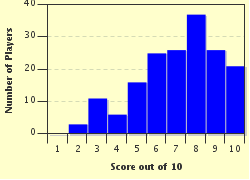Quiz Answer Key and Fun Facts
1. Where does the word pudding come from?
2. Steak and kidney pie is baked with a pastry crust, but steak and kidney pudding has a suet crust and is steamed. It was mentioned by Mrs Beeton in her 'Book of Household Management' in 1861.
What now expensive and luxurious item did Mrs Beeton include as an extra flavouring ingredient as they were both cheap and readily available at the time?
3. This batter pudding, traditionally cooked under the roast meat and served first in order to take the edge off healthy appetites, is probably one of the most quintessentially British savoury puddings of all and still an essential part of the traditional Sunday lunch. What is it called?
4. Black pudding is often one of the components of a Full English Breakfast. Sliced into discs and fried until crispy with bacon, it's absolutely delicious as long as you don't think about what it's made from. What is the rather gruesome main ingredient of this British classic?
5. "White pudding and eggs and sausages and cups of tea! How simple and beautiful was life after all!"
Who wrote this in his book, 'A Portrait of the Artist as a Young Man'?
6. Hog's pudding is still made in Cornwall and Devon, where there are various versions of the recipe. Some versions are very much like white pudding but much spicier with the addition of black pepper, cumin, basil and garlic whereas others contain offal such as liver and lights. What are lights?
7. Which pudding which has also lights as one of its ingredients is the one famously addressed by Robert Burns as, "Great chieftain o' the puddin'-race!"?
8. Easter Ledger Pudding, eaten during Lent in the north of England, is a very ancient and unusual delicacy combining the young leaves of the bistort plant with oatmeal, nettles, onions and seasoning and usually fried with bacon.
It is also sometimes called after which wild plant, better known for soothing the pain of stinging nettles?
9. A mixture of yellow split or Carlin peas, soaked and boiled and flavoured with spices and vegetables and cooked down to a soft, pale yellow hummus-like paste is known as?
10. Salmon pudding, a type of savoury custard made with breadcrumbs, cream, eggs and seasoning is one of the recipes recorded by the author of 'Modern Cookery' in 1845. What was her name?
Source: Author
alex_april
This quiz was reviewed by FunTrivia editor
WesleyCrusher before going online.
Any errors found in FunTrivia content are routinely corrected through our feedback system.

